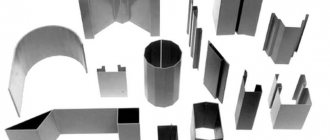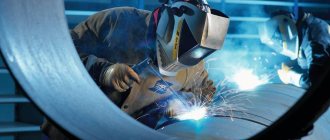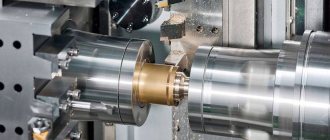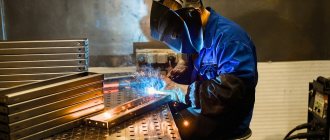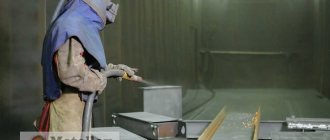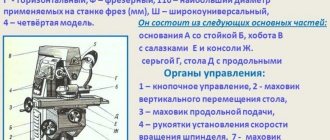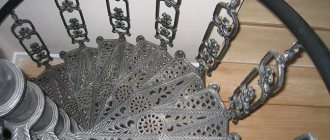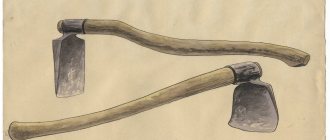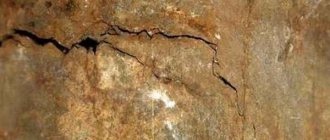Forging and hot stamping is one of the three main areas of pressure processing of piece workpieces made of metals and alloys. Due to the fact that the ability of a metal to deform significantly increases with increasing temperature, using hot pressure treatment methods it is possible to produce products of arbitrarily complex shapes, even from steels with relatively low ductility (for example, high-alloy steels). Moreover, some alloys are pressed exclusively when hot.
- Area of distribution of hot pressure treatment operations and its types
- Metal forging
- Hot stamping
The essence and purpose of forging
The collective term “forging” means a set of hot plastic processing processes in which the metal is shaped using a non-profiled tool, and the material is allowed to flow freely in all directions except the one in which the deforming force is applied.
The starting metal for forging is ingots, blanks or rod profiles. Forging cast blanks and blanks is common in large metal-intensive mechanical engineering, and small forging shops prefer to forge metal in the form of rods.
The sequence of forging transitions is as follows. The source metal, which arrives at the site from the foundry shop or from the warehouse, is cleaned from mill scale or rust, after which it is cut/chopped into measured pieces, transferred to the forging site, where it is deformed by specialized equipment - mainly forging presses or hammers. Then the workpiece undergoes cleaning and, if necessary, heat treatment. After this, the semi-finished product can be sent to the stamping or machine tool area, where final (finishing) operations will be performed on it.
Thus, forging is rarely a transition that results in a product of final shape and size.
Cutting ingots is the primary forging operation, which is carried out on saws or, less commonly, on forging hammers using forging axes, a sharp-edged tool. Even less often, when processing particularly large-sized workpieces, cold-breaking is used.
Press shears are used to cut rods. Cutting with scissors is the cheapest, most productive and widespread operation, which provides increased cutting accuracy and productivity. In small-scale and single-piece production, they try to choose a rod with dimensions that are as close as possible to the dimensions of the forging, so sometimes they do without cutting equipment.
In machine forging technology, a distinction is made between preparatory and finishing operations. The first, in addition to cutting, include upsetting, bending, twisting, pulling, twisting and other operations that are performed using flat strikers. At the final transitions, metal forging involves the use of a backing forming tool, with the help of which the transitions of pinching and broaching are performed. After these transitions, the workpiece acquires the approximate shape of a forging in terms of length and cross-sectional dimensions.
Stamped steel rims - the secret of popularity
More than 60% of all cars in the post-Soviet countries are equipped with disks made of sheet carbon steel. The vast majority of these cars are equipped with these wheels from the factory, since they are cheaper than others. Exceptions are cars in luxury configurations or luxury brands, for which the “stamping” frankly does not suit the appearance.
Traditional stamped wheels
Despite their cheapness, iron wheels have many advantages:
- Compared to aluminum alloy, steel has ductility and elasticity, so the rim partially absorbs impacts when driving over large uneven surfaces;
- for the same reason, steel products are easy to repair - deformed areas can be straightened, and cracks can be welded;
- scope of application - transport of any purpose and carrying capacity;
- low prices for wheel maintenance;
- There are no problems with fastening the wheels, for which factory (standard) bolts are used.
A bent stamping can be rolled and successfully straightened
The most valuable advantage when driving on our roads is the high maintainability of stamped wheels and the ability to absorb shocks. Combined with low cost, these features make traditional iron rims the most attractive in the eyes of ordinary users. To understand how their cost is formed, it would not hurt to familiarize yourself with the manufacturing technology of such products.
Production by stamping
Thick sheet steel is used to make iron rims. Two types of workpieces are cut from it - a circle and a strip, sent for further processing. The process looks like this:
- On a hydraulic press, the core of the future disk with holes for bolts and technological openings is stamped from a steel circle.
- The strip is sent to rollers, where it is bent into a cylinder shape. The ends of the sheet are welded together, after which the seam is cleaned.
- A hydraulic press squeezes the finished rim out of the cylinder, then a hole for the valve is drilled in it.
- Both elements are connected by welding, then covered with primer and painted.
After the impact of the press, the steel circle turns into the middle part of the rim
In the manufacture of stamped products, expensive CNC machines and furnaces are not used, which is why energy costs are significantly lower. Hence the low price of the final product.
The rim is welded to the middle part
Video of the assembly process of stamped products
Weaknesses of steel wheels
Compared to attractive products made from light aluminum alloy, stamped iron rims are inferior in appearance, which often becomes the reason for their replacement. Plastic decorative caps, which always get lost on potholes on our roads, do not solve the problem, and the car owner has to buy new ones.
For reference. To prevent the hubcaps from flying off the wheels, many drivers fasten them to the rims with plastic electrical clamps. This helps, although it somewhat spoils the appearance of the car.
Original hubcaps from Volkswagen cost incredible amounts of money, but are lost less often due to good fastening
There are other negative aspects in using “stampings”:
- due to the large weight of the wheels, the car’s handling is worse and fuel consumption is higher;
- increased braking distance;
- products made of stamped iron cannot boast of good balancing;
- metal rusts and therefore requires maintenance.
Judging by the statistics, the listed shortcomings do not bother most Russian drivers too much. Again, some of the negative aspects are misinterpreted by sellers. For example, there is no basis for the statement that steel can rot in 2 years and the disk will become unsuitable for further use. To bring the metal to this state, it will take twice as long, and with timely care, the product will last no less than light alloy.
Note. There is a myth that the paint of stamped rims is easily scratched and quickly becomes unusable, but the light alloy surface cannot be damaged. The second part of the statement is incorrect; alloy wheels can also be scratched, but painting them is much more difficult.
Types of forging
Metal forging processes can be classified according to the following parameters:
- Depending on the type of equipment used - manual or driven forging machines;
- According to the temperature of the metal being processed - hot, semi-hot or cold;
- By materials - forging steel or non-ferrous metals/alloys.
The choice of technology is determined by the dimensions of the finished forging, the serial production and the dimensional accuracy of the finished product.
hot
Since the metal has the best ductility in a heated state, hot forging is the predominant type of the process under consideration. The choice of forging temperature depends on the grade of metal. For example, for conventional carbon steels, the starting point for selection is always the iron-carbon diagram. For hypoeutectoid steels, the heating temperature of the metal is higher than for hypereutectoid steels, and with a decrease in the amount of carbon, the temperature at which forging begins is higher.
The average range of forging temperatures is from 12000C to 8000C, however, blacksmiths never use the concept of “heating temperature”, but instead use two indicators - the temperature of the beginning and end of forging. The fact is that when unloading from the furnace, the metal begins to cool; Depending on the cross-section of the blank or ingot, the temperature drop can be up to 1000C/10 mm cross-section, so the metal is heated to temperatures that are approximately 300C above the upper limit of forging.
When the temperature is exceeded by inexperienced heaters, two unpleasant phenomena can occur - overheating and burning of the metal. In the first case, the structure of the heated metal becomes coarse-grained, which increases the risk of cracking of the workpiece, especially during intensive forming. Overheating is eliminated by slowly cooling the original workpiece and reheating it to the required temperatures. If the workpiece is overheated even more, the metal burns out, accompanied by irreversible changes in its microstructure. In particular, non-metallic inclusions (for example, sulfur) melt, and it is no longer possible to correct such defects.
The end of forging usually corresponds to the conditions for the formation of large grains in the structure, when the metal’s resistance to plastic deformation increases sharply (especially for steels with a high carbon content). This leads to an increase in the required deforming force and reduces the tool life.
Manual
It is used in small repair shops, as well as in enterprises that engage in technological processes of artistic forging. Here, metalworking processes are as close as possible to the working conditions of blacksmiths of the past: open furnaces are used to heat the source metal, a hand hammer and anvil are used as working tools, and bellows with a mechanized drive are used to supply air.
A specific manual forging operation is forge butt welding of several fragments of the original workpiece, in which the crimping of the joined sections occurs due to a combined thermal and force effect on the metal. Since there are no thermal stresses inherent in traditional types of welding, the performance and durability of the welded joint is noticeably higher.
Cold
The process of forging metal, in which the temperature of the original workpiece is no more than 25% of the melting point of the metal from which it is made, is called cold forging. The concept of cold forging should not be confused with the concept of forging metal at room temperature: for example, the plastic processing of lead in most cases will meet the conditions of hot forging, and the deformation of tungsten at a temperature of 650...7000C will meet the conditions of cold deformation.
Cold forging is common in small workshops that produce small metal forms - figurines, canopies, railings, balustrades, etc. The initial type of rolled metal here is profiled metal - rods, strips, and the predominant type of plastic deformation is bending, twisting, embossing. Cold forging is used mainly for non-ferrous rolled metal, the surface of which has virtually no scaling.
Area of distribution of hot pressure treatment operations and its types
The production of forgings and stampings by hot deformation is determined by the temperature at which the deformed metal ceases to be hardened. Hardening manifests itself as constantly increasing values of the plastic limit. As a result, more and more force has to be applied to the metal, which negatively affects the energy consumption of deforming machines. During hot pressure treatment, the mobility of the grains of the macrostructure increases, and their movement becomes easier. Therefore, the specific forces are noticeably reduced, so it becomes possible to shape steel with high degrees of deformation without fear of destruction of the workpiece.
Forging and stamping are the main types of hot forming. Accordingly, the production equipment in the first case is called forging, and in the second - forging and stamping.
The uncontrollability of thermal expansion of metal during hot forming in most cases does not make it possible to manufacture products without tolerances and allowances. Therefore, forgings and stampings are blanks that are then subject to mechanical modification along the contour, drilling holes, making grooves or fillet grooves.
Thus, by forging and stamping we understand the technology of hot metal forming, which is carried out at temperatures at the end of the austenitic transformation. For low-carbon and unalloyed steels this is a temperature range of 1050...12000C, and for high-carbon and alloyed steels - 850...9500C.
Equipment and tools
The most common types of forging equipment in industrial production are steam-air (or pneumatic) forging hammers and presses. The former are deformed by impact energy, the latter by applied force. Since the stored power of a single blow of a hammer strongly depends on the mass of its falling parts, in order to increase productivity, several blows of the moving part of the hammer - the head - are practiced on the metal being forged. The mass of falling parts of a forging hammer usually does not exceed 25 tons; If it is necessary to develop increased energy of plastic deformation, hydraulic forging presses are used, the nominal force of which reaches 150...200 thousand tons.
Specialized forging equipment, for example, twist-out or horizontal forging machines, is used much less frequently.
To move large forgings during processing, forging manipulators of rail or trackless types are used. The movement of forgings, medium in size, is carried out using tilters.
The range of forging tools is represented by forging axes, broaches, overlays and piercings. The tool is placed on top of the workpiece, after which the hammer head or press slide is driven to perform the forming.
Metal processing techniques (forging operations)
Forging technology includes a number of basic transitions, the choice of which is determined by the final shape of the forging and the capabilities of the forming equipment
Draft
It consists of increasing the cross-section of the forging by reducing its height. It is divided into free and closed. Free upsetting is almost always the primary forging operation, allowing the metal to be pre-distributed along the length of the forging.
Disembarkation
It is the settling of a part of the workpiece, with the main part of it being placed outside the zone of action of the hammer striker or press slide. Upsetting produces forgings with a significant redistribution of metal along the axis.
Pulling (drawing)
An operation used to significantly lengthen a forging. It is always performed with several strikes of the striker or presses of the slide with the corresponding movement of the workpiece along the equipment plate. Broaching of especially large workpieces is often carried out with several successive heatings in a furnace.
Rolling and broaching with rolling
This is the name of the operation, during which the workpiece is simultaneously pressed with a striker or slide while simultaneously rotating the semi-finished product on a special mandrel. Used for plastic deformation of tubular or ring-shaped workpieces.
Firmware
The operation is intended to produce through or blind holes in a forging. It is carried out using a piercing, the force on which is exerted by the hammer head or the press slide.
Chopping
The primary forging operation, which consists of separating blanks from the primary rolled profile or separating several similar forgings from each other. Performed using blacksmith axes.
Bending
The transition consists of changing the direction of individual parts of the workpiece. It is rarely used for bulk metal rolling, but is indispensable for cold forging of sheet products.
